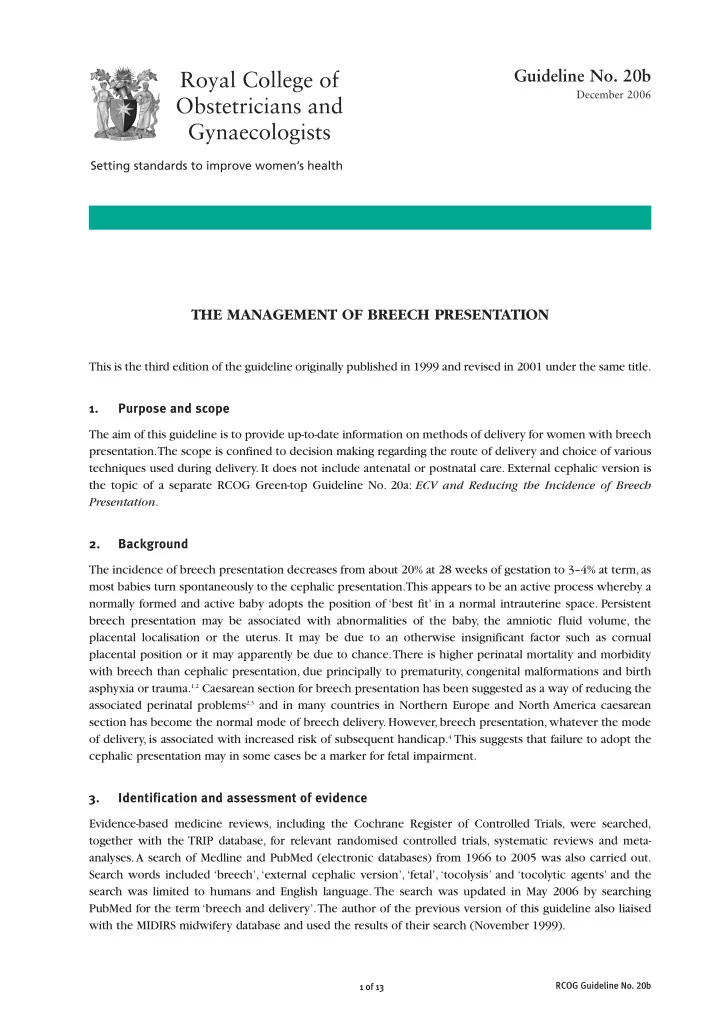

Guideline No. 20b December 2006 THE MANAGEMENT OF BREECH PRESENTATION This is the third edition of the guideline originally published in 1999 and revised in 2001 under the same title. 1. Purpose and scope The aim of this guideline is to provide up-to-date information on methods of delivery for women with breech presentation. The scope is confined to decision making regarding the route of delivery and choice of various techniques used during delivery. It does not include antenatal or postnatal care. External cephalic version is the topic of a separate RCOG Green-top Guideline No. 20a: ECV and Reducing the Incidence of Breech Presentation . 2. Background The incidence of breech presentation decreases from about 20% at 28 weeks of gestation to 3–4% at term, as most babies turn spontaneously to the cephalic presentation. This appears to be an active process whereby a normally formed and active baby adopts the position of ‘best fit’ in a normal intrauterine space. Persistent breech presentation may be associated with abnormalities of the baby, the amniotic fluid volume, the placental localisation or the uterus. It may be due to an otherwise insignificant factor such as cornual placental position or it may apparently be due to chance. There is higher perinatal mortality and morbidity with breech than cephalic presentation, due principally to prematurity, congenital malformations and birth asphyxia or trauma. 1,2 Caesarean section for breech presentation has been suggested as a way of reducing the associated perinatal problems 2,3 and in many countries in Northern Europe and North America caesarean section has become the normal mode of breech delivery. However, breech presentation, whatever the mode of delivery, is associated with increased risk of subsequent handicap. 4 This suggests that failure to adopt the cephalic presentation may in some cases be a marker for fetal impairment. 3. Identification and assessment of evidence Evidence-based medicine reviews, including the Cochrane Register of Controlled Trials, were searched, together with the TRIP database, for relevant randomised controlled trials, systematic reviews and meta- analyses. A search of Medline and PubMed (electronic databases) from 1966 to 2005 was also carried out. Search words included ‘breech’, ‘external cephalic version’, ‘fetal’, ‘tocolysis’ and ‘tocolytic agents’ and the search was limited to humans and English language. The search was updated in May 2006 by searching PubMed for the term ‘breech and delivery’. The author of the previous version of this guideline also liaised with the MIDIRS midwifery database and used the results of their search (November 1999). RCOG Guideline No. 20 b 1 of 13
4. What information should be given to women with breech presentation regarding mode of delivery? Women should be informed of the benefits and risks, both for the current and for future pregnancies, of A planned caesarean section versus planned vaginal delivery for breech presentation at term. 4.1 What information about the baby should be given to women with breech presentation regarding mode of delivery? Women should be informed that planned caesarean section carries a reduced perinatal mortality and A early neonatal morbidity for babies with a breech presentation at term compared with planned vaginal birth. Women should be informed that there is no evidence that the long term health of babies with a breech A presentation delivered at term is influenced by how the baby is born. A systematic review of randomised trials comparing a policy of intended caesarean section with a policy of intended vaginal birth, included three trials with 2396 participants. 5 Caesarean delivery occurred in 1060/1169 (91%) of those women allocated to planned caesarean section and 550/1227 (45%) of those allocated to a vaginal delivery protocol. Perinatal or neonatal death Evidence level Ia (excluding fatal anomalies) or short-term neonatal morbidity was reduced with a policy of planned caesarean section (RR 0.33, 95% CI 0.19–0.56) and perinatal or neonatal death alone (excluding fatal anomalies) was reduced with a policy of planned caesarean section (RR 0.29, 95% CI 0.10–0.86). Most of the data for the review were contributed by the Term Breech Trial. 6 After excluding the following cases: deliveries that occurred after a prolonged labour, labours that were induced or augmented with oxytocin or prostaglandins, cases where there was a footling or uncertain type of breech presentation at delivery and those cases for whom there was no skilled or experienced clinician present at the birth, the risk of the combined outcome of perinatal mortality, neonatal mortality or serious neonatal morbidity with planned caesarean section compared with planned vaginal birth was 16/1006 (1.6%) compared with 23/704 (3.3%) (RR 0.49; CI 0.26–0.91); P = 0.02). In a further subanalysis, the findings suggested that the benefits of delivery by caesarean section were more significant in countries with a low perinatal mortality rate. 7 In another subgroup analysis, planned caesarean was associated with a lower risk of adverse Evidence outcome due to complications of both labour (RR 0.14, 95% CI 0.04–0.45, P < 0.001) and delivery level Ib (RR 0.37, 95% CI 0.16–0.87, P = 0.03), compared with planned vaginal birth. 8 In a secondary analysis of the data from the Term Breech Trial (not according to group allocation), adverse perinatal outcome was lowest with prelabour caesarean section and increased with caesarean section in early labour (latent phase), in active labour and vaginal birth. For women experiencing labour, adverse perinatal outcome was also associated with labour augmentation, birth weight less than 2.8 kg, longer time between pushing and delivery and no experienced clinician at delivery. 9 Evidence level III The publication of the Term Breech Trial was followed within 2 months by an increased use of caesarean section for breech presentation in the Netherlands (50–80%) and improved neonatal outcome. 10 A number of questions were raised following publication of the Term Breech Trial, 11 largely about selection criteria and the conduct of labour. At that time there was evidence available to indicate that different strategies would eliminate the benefits of planned caesarean section for the baby. RCOG Guideline No. 20 b 2 of 13
Recommend
More recommend